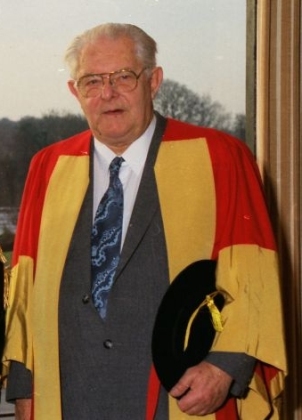Outstanding geologist who developed sources of clean hot water for the thermal spas of Bath
 Geoffrey (Geoff) Kellaway, a Fellow for 74 years, died in Brighton on 18 September 2013. Born in Bristol in 1914, he graduated with the top First Class Science Degree of Bristol University in 1936. The excellence of his research was recognised by DSc degrees from the universities of both Bristol and of Bath.
Geoffrey (Geoff) Kellaway, a Fellow for 74 years, died in Brighton on 18 September 2013. Born in Bristol in 1914, he graduated with the top First Class Science Degree of Bristol University in 1936. The excellence of his research was recognised by DSc degrees from the universities of both Bristol and of Bath.
Geoff joined the British Geological Survey in 1937, initially revising the One-Inch Yeovil geology map. In 1940 Geoff was posted to the Northamptonshire ironstone field, as a result of the wartime concentration of Survey work in areas of economic importance. Back in the Bristol area in 1943, Geoff worked on the Six-Inch geological survey of the Bristol/Somerset coalfields, producing the Bristol District Special One-Inch Sheet with F B A Welch, illustrated by memoirs in 1948 and 1993. Funded by the Royal Society, he studied the permafrost of Alaska and Canada in 1954, gaining knowledge which was incorporated into later joint papers with other authors on Quaternary structures of the UK. Geoff was promoted to Senior Geologist in 1945 and District Geologist/ Senior Principal Scientific Officer in 1962, retiring in 1974.
In retirement, Geoff undertook a major task, of great public service, on the hot springs of Bath. In 1977 the discovery of the pathogenic amoebae
Naegleria fowleri resulted in the closure of the spa water bathing pools, and for the first time since the Roman occupation the thermal springs were not in use by Man. The leaders of Bath and North-East Somerset Council paid this tribute to Geoff: “During the period 1978 to 1987, Geoff led a multi-disciplinary investigation to find a source of clean water for use in the Pump Room and to enable the Council to restore Spa bathing to the City. The culmination of these efforts was the skilful drilling of an inclined borehole to intercept the flow of thermal water from the King’s Spring where it was proved to be a secure and hygienic source of thermal water. Geoff edited a review of the research in
“The Hot Springs of Bath”. His interest in the hot springs continued undiminished and, originating from the successful proposal to build a new Millennium Spa in Bath, he led a further multi-disciplinary investigation into their origin between 1999 and 2002.”
Those who worked with Geoff remember him as a free thinker, who spoke persuasively about his current ideas and projects. His 1971
Nature paper on
“Glaciation and the Stones of Stonehenge” challenged the idea of human transportation of the stones in favour of a glacial origin. This led to a lively public debate, especially with archaeologist Professor Glyn Daniel (Cambridge University), the originator of what Geoff referred to (more than a little sneeringly) as the 'boating party hypothesis'.
Geoff married Bronwyn in 1939, who died aged 84 years in 1999. He is survived by his two daughters, three grandchildren and two great-grandchildren.
By Clive McCann, with contributions from: Andrew Morrison, (BGS Archivist), Jo Farrar, Paul Crossley, Mark Williams, Geoff’s daughters (Zoe and Ros), Desmond Donovan, Ramues Gallois, David McCann and Ted Nield.